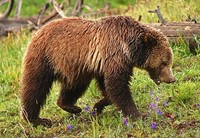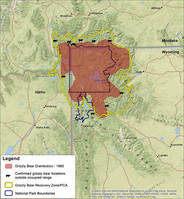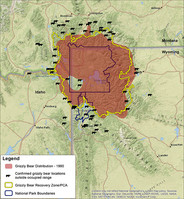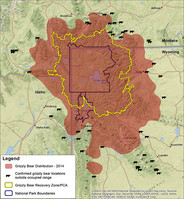Clear, 35° F
U.S. Fish and Wildlife Service proposed removing Greater Yellowstone Ecosystem (GYE) grizzlies from the Endangered Species Act list this year.
“This plan we’re going to discuss tonight is a (Game and Fish) Commission-approved plan,” said …
This item is available in full to subscribers.
The Powell Tribune has expanded its online content. To continue reading, you will need to either log in to your subscriber account, or purchase a subscription.
If you are a current print subscriber, you can set up a free web account by clicking here.
If you already have a web account, but need to reset it, you can do so by clicking here.
If you would like to purchase a subscription click here.
Please log in to continue |
|





When the Wyoming Game and Fish Department discussed its proposed draft grizzly bear management plan Monday evening in Cody, most of the 50 or so in attendance supported the plan, but, not all.
U.S. Fish and Wildlife Service proposed removing Greater Yellowstone Ecosystem (GYE) grizzlies from the Endangered Species Act list this year.
“This plan we’re going to discuss tonight is a (Game and Fish) Commission-approved plan,” said Brian Nesvik, Game and Fish chief of wildlife. Thus far, the commission has made no decisions regarding hunting.
In 1975, GYE grizzlies were listed as threatened under the Endangered Species Act, Nesvik said. Recovery criteria was measured by Fish and Wildlife and it will decide whether to delist grizzlies.
That recovery criteria was met or exceeded in 2004, Nesvik said.
Recovery criteria required a population of at least 500 GYE grizzlies, Nesvik said.
According to Game and Fish, the GYE population exceeded 500 in 2002 and has, for the most part, increased steadily to more than 700 by 2014.
Recovery criteria also required 16 of 18 bear management units (BMU) within the recovery zone be occupied by females with cubs.
In 2013 and 2014, all 18 BMUs contained females with cubs.
Recovery criteria mandates no discretionary mortality if the population dips below 600, unless the bears threaten human safety, Nesvik said. If the population is lower, mortality limits will be lower. If the population is higher, mortality limits will be higher. “... limits will ensure the grizzly population does not decline,” he said.
Discretionary mortality includes the removal of conflict bears and hunting.
On and off
In 2007, GYE grizzlies were removed from federal protections, but lawsuits prompted a court ruling placing the bear back on the list the following year, Nesvik said. A judge re-listed the bears because he believed there were not adequate regulatory mechanisms and due to the loss of whitebark pine.
Fish and Wildlife found that regulatory mechanisms were adequate, Nesvik said.
The 2013 food synthesis report, prepared for the Interagency Grizzly Bear Study Team, said grizzlies found food from a variety of sources when whitebark nuts were unavailable.
“Bears are regularly eating 75 different types of food annually,” said Dan Thompson, Game and Fish Lander statewide supervisor of the large carnivore management section.
“This management plan ensures for a healthy, viable population,” Nesvik said.
Management mastery
Wyoming wants to manage its grizzlies.
Wyoming Game and Fish “certainly” has the expertise to do it, Nesvik said.
“We have a large, large carnivore section. And the large carnivore section has been engaged in that since 1990s.”
The transition from Fish and Wildlife to Game and Fish control of the bear would be seamless from Game and Fish’s perspective, Nesvik said. Arguably grizzly bears are the most widely studied animal in the world. “We really take pride in what we do. Hopefully things can move forward with grizzly bears.”
If the animal is delisted, the commission will decide whether to hunt the animals. Part of the decision-making process will entail seeking public opinion, Nesvik said.
“There is a whole lot of regulations if they do decide to hunt,” he said.
If hunting is allowed, a regulation would prohibit the harvest of sows with cubs or taking the cubs, Nesvik said. Hunters may be required to take a grizzly ecology course and pack bear spray.
Questions and comments
Chuck Neal of Cody said grizzlies are welcome within the demographic monitoring area (DMA), but unwelcome outside of it. “You build an invisible line bears will not be allowed beyond,” Neal said.
The DMA circles Yellowstone National Park reaching north, south, east and west a few miles beyond the park’s boundaries.
“Unwelcome,” Nesvik said. “That was your word, not ours.”
Inside the DMA, grizzlies are biologically and socially acceptable. Outside the DMA, human uses will be the primary concern, Nesvik said. Grizzly deaths outside the DMA will not be counted in mortality limits, but neither will births counted as population increases.
More mortalities can be expected in areas outside the DMA as the grizzly bear population expands, particularly in areas on the edge of the range when bears move on to private lands or in areas with higher levels of human development, according to Fish and Wildlife’s draft plan.
The draft plan said mortality management recognizes the need for some bears to be removed to address recurring conflicts to meet management needs for nuisance bears, human safety issues and more.
Neal said the Wyoming Range would be good habitat for grizzlies.
Most of the Wyoming Range (paralleling Star Valley) is south of the DMA.
Allowing grizzlies to occupy the Wyoming Range is up to the discretion of the Game and Fish Commission, if the public supports it, Nesvik said.
Another question from the audience was connecting GYE grizzlies with Northern Continental Divide System bears in northwest Montana to aid genetic connectivity.
That would be a Fish and Wildlife/state of Montana decision, Nesvik said. However, GYE grizzly inbreeding is 0.2 percent.
“This is a genetically viable population as it stands,” he said.
All three states are closely monitoring genetics, Nesvik added.
Dewey Vanderhoff of Cody asked how confident they were that state and federal funding will be available in the future.
“How about the money end of it? I’m a money-following kind of guy,” he said.
Most of the $40 million invested in Wyoming grizzly bears in the last 40 years has been Cowboy State money, with less than 10 percent from federal coffers, Nesvik said. Wyoming has survived many boom and bust cycles, but the state has remained committed to grizzly funding throughout, Nesvik said. “I don’t see that changing,” he said.
Park County Commissioner Loren Grosskopf encouraged members of the audience to read Fish and Wildlife’s proposal to delist. Fish and Wildlife will present its plan beginning at 2 p.m. on Monday at the Holiday Inn in Cody. “This is the best chance of making comments on that,” he said.
Lee Livingston, Park County Commissioner and outfitter, supports delisting. “It’s been a long time coming,” Livingston said.
The Yellowstone Country Bear Hunters Association appreciates Game and Fish’s efforts to reach this juncture in the delisting process, said association president Joe Kondelis. He also thanked hunters, who contribute to grizzly conservation efforts by purchasing hunting licenses and conservation stamps.
Kondelis said he’d like to see stock growers who lose stock be granted damage permits to remove grizzlies killing stock.
“We’ve got too many (grizzly) bears,” said Curt Bales, who ranches south of Cody. “It’s time to do something about it.”
Sierra Club Greater Yellowstone/Northern Rockies’ senior campaign representative Bonnie Rice said the organization has concerns about delisting and thinks it is premature.
“Wyoming’s plan is a big step backward for grizzly recovery,” Rice said in a email prior to the meeting. “Instead of securing a future for bears, it undermines their ability to flourish — even completely eliminating bears from some areas where they currently live.”
The agreement between Wyoming, Montana and Idaho incorporated into Wyoming’s management plan allows “far too many bears to be killed to sustain a healthy population and reach full recovery,” she wrote. “Together with the planned sport trophy hunt, the history of hostile state management policies toward large carnivores, and grizzly bears’ slow reproduction rate, bears could soon be in steep decline under this plan.
“Grizzly bears are a vital part of the fabric of the Yellowstone region. They are sacred to many Native American tribes, an essential symbol of the wild that so many people in the region value, and a positive economic driver. People, bears and livestock can co-exist when given the chance.”